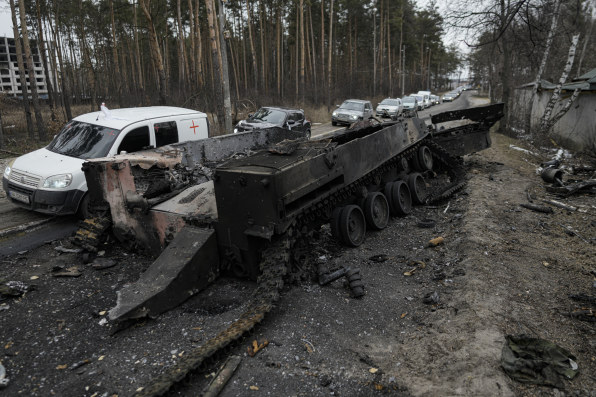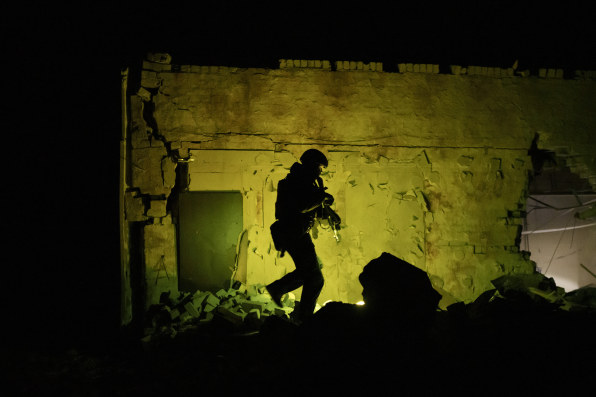Stalingrad tank division destroyed as key town retaken
KEY POSTS
Zelensky insists on territorial integrity before new peace talks
Historic Russian tank division destroyed as Ukraine retakes key town
Scared Russian soldier caught short by Ukraine advance
Russia seizes Audemars Piguet watches in sanctions retaliation
Backlash at Biden for ‘Putin must go’ comment
Ukraine claims victories near Kyiv: latest
Historic Russian tank division destroyed as Ukraine retakes key town
The Telegraph UK
In the annals of Soviet military history, Russia’s 4th Guards tank division is legendary, its reputation forged at Stalingrad and in the liberation of Poland from the Nazis. On Saturday, it was routed in Trostyanets, a town 350 kilometres due east of Kyiv. If evidence was needed that Vladimir Putin’s invasion was faltering, the images of burnt out howitzers and tanks of the elite division will surely shake the resolve, even among the Kremlin’s most loyal supporters.
Just 24 kilometres from the Russian border, Trostyanets was attacked at the start of the invasion and seized by Russian troops on March 1 after a week-long battle. The armoured vehicles rolled into the main square, their movements caught on mobile phone footage by residents and posted on social media.

Cars drive past a destroyed Russian tank. AP
And now almost four weeks later, the same tanks and artillery units from the 4th tank division that were filmed manoeuvring in the town square, lie burnt out and the Russian forces either captured or killed by Ukrainian troops and local “guerilla” forces.
After 25 days under Kremlin control, Trostyanets was once again flying the Ukrainian flag yesterday. The significance of the victory should not be underestimated.
Trostyanets sits on a main road 50 kilometres south of Sumy, a city that has been under siege for almost a month. The counter-offensive to grab back Trostyanets offers the hope of opening up a supply route – for military reinforcements as well as food and medicines – to Sumy and its population of 250,000.
To the south is Okhtyrka, a large town that has been carpet bombed by Russia but has refused to surrender, in doing so helping to keep open a direct route between Kyiv and Ukraine’s second largest city, Kharkiv.
Recapturing Trostyanets removes a Russian springboard for further assaults and raises serious questions about the Kremlin’s ability not just to conquer territory but then keep it.
Footage online yesterday showed Ukraine’s troops advancing in the Sumy region, soldiers on foot in battle fatigues behind the cover of an armoured vehicle firing at Russian positions. The firefight ends with a huge explosion after a Ukrainian tank fires at the enemy. In the next scene, about 10 Russian troops, each wearing red armbands, are filmed lying face down in a field or yard with burning homes in the background.
The soldiers’ arms are outstretched as each in turn is searched by their Ukrainian captors.
“Trostyanets is free from Russian occupation,” proclaimed the Facebook page of Ukraine’s 93rd Mechanised Brigade, named Kholodny Yar after the last piece of Ukrainian territory to be incorporated into the Soviet Union, four years after the Russian Revolution.
Photographs on the page showed the Ukrainian military leaders shaking hands with liberated townsfolk and posing in front of a burnt out 2S19 Msta self-propelled howitzer, a huge gun based on a tank hull, capable of firing 152.4 mm shells 24 kilometres. The howitzers had been deployed by Putin in the Second Chechen War and in his invasion of eastern Ukraine in 2014.
In another photograph, four soldiers in battle fatigues pose in front of boxes of Russian ammunition piled high and newly captured.
Other images showed the devastation and destruction after a month’s fighting.
The page went on: “Today, the 93rd Mechanised Brigade, with the help of territorial defence forces and local partisans, has liberated Trostyanets in the Sumy region from Russian occupation.
“Kholodny Yar fighters have managed to expel the ‘elite’ Russian ground force troops, the Kantemyr tank division 4th Guards. This was preceded by the defeat of the command post and the leadership of the 96th Separate Reconnaissance Brigade in the first days of the defence of Okhtyrka and the battles for Trostyanets.
“The Russian army has fled Trostyanets, leaving behind weapons, equipment and ammunition that the 93rd Brigade will use to liberate other Ukrainian cities.”
The Russian occupation of the town will be subject to war crime investigations and the regional prosecutor’s office in Sumy has opened a file after it was claimed that Russian troops had thrown hand grenades at civilians protesting at the Kremlin takeover on March 18. The blast killed two men.

A Ukrainian special police officer walks next to a destroyed building as he patrols during night curfew in Kharkiv on Sunday. AP
Philip Ingram, a former colonel in British military intelligence, said: “Trostyanets is a town on a significant north-south route between Sumy and Okhtyrka. If Ukraine has control of that road, then you are seriously restricting Russia’s ability to manoeuvre. Any roads Ukraine takes back impacts Russia’s ability to move around. The Russians are constrained to the roads and control of the junctions gives you firing positions straight down them.”
It remains unclear where the Ukraine defensive positions are in the region but their ability to mount counter-attacks a month after the invasion suggests Russia has failed to land knockout blows even in areas close to its border where supply lines are shorter and logistics in theory less problematic. Ingram said that a combination of hand-held anti-tank weaponry supplied by the West, mainly Javelins and next-generation light anti-tank weapons (NLAWS), were doing the damage to the Russian forces along with drone strikes. Ukraine’s armoured infantry still appears to be able to manoeuvre along battle lines as the Kremlin fails to gain air superiority and is unable to knock out Ukrainian tanks.
Russia has lost about 10,000 troops with a further 30,000 to 40,000 wounded, according to Western officials, a quarter of its fighting force.
The 4th Guards tank division – also known as the Kantemirovskaya, after a village it had liberated from the Germans in its “baptism of fire” in 1943 – has suffered “significant” losses, according to various reports. Photographs on social media of burnt out or abandoned vehicles involved in fighting on the road to Sumy back up the claims.
In one video, a mobile kitchen truck, containing potatoes and onions and even a drawer filled with jars of pickles, was left abandoned as Russians appears, in places, to be fleeing the battlefield.
Sofrep, a military website based in the US, describes the 4th Guards as “one of the more elite armoured divisions of the Russian ground forces” comprising two tank regiments, a motor rifle regiment and its own air defence regiment.
The division is revered in Russia to such an extent that a Moscow metro station is named Kantemirovskaya in its honour. The unit participated in the Battle of Kursk and the capture of Berlin in World War II.
In Kharkiv, Ukraine’s second-largest city, it remains unclear if Russia has yet succeeded in cutting off supply lines while videos posted online show a large group of Russian troops taken prisoner. In unverified footage from Kharkiv, circulated by Kremlin supporters, it was claimed that Russian prisoners of war were being shot in the leg by Ukrainian troops after they had been captured.
No comments:
Post a Comment